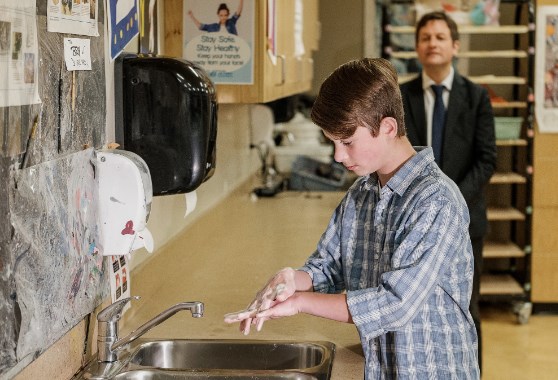B.C. Education Minister Rob Fleming says “science” is driving his government’s policy to get students back to school in September, however the physical distancing standards put in place for children are much lower than those of his own workplace, the B.C. Legislature, where provincial politicians have provided one another ample space by attending remotely.
It’s a double standard that sends a confusing message to the public on limiting the spread of COVID-19, teachers say.
“If you look at the legislature not meeting in person; if you look at Rob Fleming’s press conference today where he doesn’t have reporters physically there to ask questions; or where school boards are not meeting in person and they have people calling in – that to me is definitely concerning when you look at the move to have everyone face-to-face when we’re back to school,” said Janine Fraser, a Grade 2 teacher in Rock Creek and president of the B.C. Primary Teachers’ Association.
Glacier Media asked Fleming about the alleged double standard in place for school staff and students in B.C. – who will be in cohorts of up to 60 in elementary school and up to 120 in high school upon returning September 10.
Fleming defended his back-to-school plan, saying public health officials have set the guidelines.
“Schools are different than, say, a shopping mall. These are secure, controlled sites with buildings that are distributed in many configurations with many rooms. We have a learning cohort model that’s developed on the advice of [Provincial] Health Officer Dr. Bonnie Henry.”
A technical difficulty prevented a follow-up question from being asked: Can British Columbians expect to see MLAs using back-to-school guidelines for sittings at the Legislature this fall?
Fleming and others have largely been able to avoid going to the legislature, which is a secure and controlled site, not like a mall. During a summer session in Victoria, politicians were spaced greater than the two-metre guideline from the B.C. Centre for Disease Control. Only 24 MLAs attended while 63 attended online.
“When it’s different for education, it doesn’t make sense for people,” said Teri Mooring, president of the B.C. Teachers’ Federation.
Richmond city councillor and former school trustee Chak Au took to Twitter Monday to re-assert Fraser’s concerns: “If it is unsafe for adults to gather physically in a boardroom to hold meetings, how could it be safe for teachers and students to stay in schools for long hours every day?” stated Au.
But last week, B.C. deputy provincial health officer Dr. Reka Gustafson said physical distancing was only a “gradient,” when asked about why and how over two dozen students could be placed in one classroom. She and Henry maintain the cohorts can at least limit the spread of COVID-19, and emphasized other measures, such as frequent hand washing.
Prior to the back-to-school plan, physical distancing was the primary objective to prevent the spread of COVID-19, said Fraser. And Mooring noted distancing is a top priority under WorkSafe BC guidelines.
Fraser noted that the cohorts, or “bubbles” are not impenetrable. Kids will be interacting on buses with others outside their cohort and with siblings who are in their own bubbles. Henry maintains as long as people know where they have been, then augmented contact tracing can contain the spread of COVID-19 in B.C. to a certain point (the province hired 500 new contact tracers this month).
Fleming endorsed the back-to-school plan Wednesday and assured parents that remote learning options will be available, should students choose to stay at home. School districts will all have unique plans, said Fleming.
The school plan calls for anyone with symptoms of illness and/or COVID-19 to stay home and get tested. However students not showing symptoms may still attend school, even if a household member is showing symptoms. Only until there is a confirmed COVID-19 case in their household should a non-symptomatic student stay home. Students will be required to wear masks in common areas. Each school will be cleaned more regularly, as well.
Fleming said the government has looked at other jurisdictions to see how their school plans have worked. One is New Zealand, which has suppressed the virus relatively well. However, a school outbreak is one of that country’s biggest, according to media reports.
Despite Fleming’s assertions, the government concedes online that “due to widespread, worldwide school closures, there are few studies on the effects of COVID-19 transmission in school settings.”
The government notes, “In places that have resumed in-class instruction, children do not appear to be the primary spreaders of COVID-19.”
Depending the advice of Henry, schools can move up and down a five-stage framework, where Stage 1 is what would be considered “normal” and Stage 5 is full remote learning as was the case from April to May. Right now students and teachers will return in Stage 2 with no “density targets.” Stage 3 would mean schools operating a 50% capacity, with spaces saved for children of essential workers. It has not been made clear at what level of community spread and infection will Henry call for a move to Stage 3.
Mooring said questions remain about the plan, including who would be teaching the remote learning classes. Teachers, said Mooring, cannot do in-class and online learning at the same time, as demonstrated in the June return to classes.
Mooring said additional federal funding for schools, announced Wednesday, should go to hire more teachers in order to split up classrooms. The ministry has not procured more portables, so each school would need to find extra space from within, which Mooring said is possible at most places.
“We’re hoping and expecting and we see an opportunity. The $242 million is a lot of money. That’s enough money to hire additional teachers to reduce classroom density,” she said.



